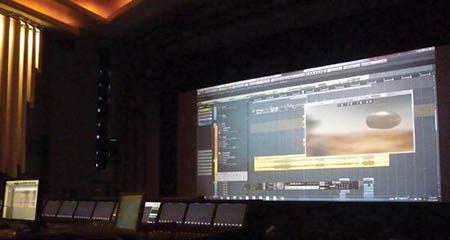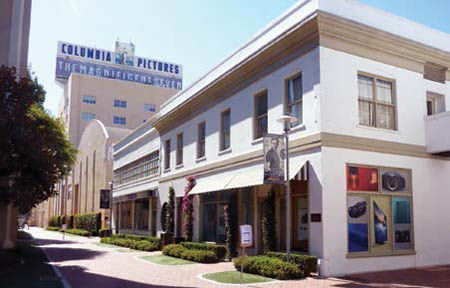The Difference Between Audio for Film, TV
The entire process of sound for film has always fascinated me partly because the working environment seems so extravagant compared to someone who has spent the majority of their professional life working in the trenches of broadcast audio for television.
The mystique perpetrated by cinema audio is that the budgets are enormous, audio is recorded on gigantic sound stages, mixed in huge mix rooms and staffed by large specialized crews; and for studio-backed widerelease films, these generalizations are fairly accurate.
Broadcast audio engineers have a totally different working experience. In broadcast audio post, a single person may end up handling the music and dialog editing, sound design and final mix; whereas in film each of these is handled by a different person. Some broadcast facilities have relatively large studios, but the budgets and crews are much smaller than those in cinema, and audio control rooms are sometimes no larger than the closet we’re able to wrest away from the video guys.

A Sony mix stageFRESH LOOK
In September of this year TV Technology sister publication Mix magazine held the third annual “Mix Presents Sound for Film and Television” event on the Sony Entertainment lot in Culver City, Calif., and it seemed like an excellent opportunity to get a fresh look at the world of cinema audio. I was particularly interested in seeing how much immersive audio work was being done and what impact the proliferation of OTT shows is having.
As soon as I arrived on the studio lot it was apparent that production for streaming has made its way to Hollywood because billboards for OTT shows are prominently displayed alongside those for broadcast networks and feature films.
The event itself made for a very full day, beginning with the keynote from Gary Bourgeois at 9:30 a.m. and finishing up 12 hours later after the screening of 13 eight-minute film segments, each introduced by the sound crew or another person involved with the film. There was a mini-trade show, sound cart demonstrations and technology master classes, but the most compelling parts of the event were the panel discussions: “Sound Inspiration Within the Storytelling Process,” “Sound Mixing Panel: Workflow for Musicals” and “Building an Immersive Room: Small, Medium and Large.” The panelists for these sessions were excellent and the audio podcasts are now available online at http://soundworkscollection.com/.
Of particular interest was a session titled, “Remastering Cinema Audio for ATSC HDTV,” led by Lon Neumann, which was, at its heart, a review of ATSC A/85. It seems the film community is still coming to grips with the CALM Act and translating cinematic- style mixes into one that plays well in the home. Neumann introduced a couple of terms I had not encountered in reference to sound for picture: “allocentric” and “egocentric,” but they perfectly sum up the differences between cinema and television.

The Sony Entertainment lot Seeing a film in the theater means participating in an allocentric event specifically designed to be shared with others, with speakers distributed around the room for wide dispersion, where everyone in the theater shares a similar experience.
Television on the other hand—especially with the increasing consumption of content on personal media devices— is a highly egocentric medium where everything, including speakers, is focused to one spot in the room creating an experience best enjoyed by one or a few people.
Creating content for these two opposing methodologies necessarily dictates mix rooms with vastly different designs and speaker layouts in order to emulate the end-user experience, which additionally complicates the translation of material between the film and television mediums.
It turns out there is now so much television, streaming and game work being done in L.A. that mix rooms are in short supply, so new ones are being built by studios as well as by mixers who have opened their own facilities. Most of these new rooms are built primarily for television and game work so the rooms being built tend to be smaller. This presents challenges for mixers who move between large and small mix rooms because they not only have to adjust to completely different spatial environments, the rooms tend to have less than ideal dimensions so low frequency build-up must be dealt with, and the smaller rooms require mixing at lower monitor levels.
Even these smaller rooms are larger than most broadcast audio mix rooms, but film sound mixers are starting to get a taste of the issues the rest of us deal with on a daily basis.
ADDITIONAL COMPLICATIONS

The Sound Inspiration Panel, from left: Carolyn Giardina (moderator), Will Files, Mark Stoeckinger, Ben Cook, Paula Fairfield, Harry Coen, Paul Menichini
One enormous additional complication presented by these smaller mix rooms when compared to broadcast mix rooms is that the majority are built for immersive audio production. That means not just more speakers, but additional acoustic design complications. The panel on building immersive rooms stressed how important it is to make the rooms deader than they would for a standard film mix room, including deadening the ceiling surfaces, to help with localization of sound sources. Every mixer who spoke about immersive audio spoke effusively about how much they enjoy working in it and how it is becoming a regular part of their workflow for film, episodic television and gaming. The general consensus among the mixers is that it’s here to stay.
Another aspect of film sound that has changed is the jobs themselves. Thanks to the smaller budgets of today’s television shows, the sheer amount of work to be done and the workflow efficiencies gained by being able to work completely in the box, the lines are starting to blur and individuals on sound crews are more often filling multiple roles.
It was a pleasure to see how OTT and gaming has reinvigorated the film sound community, but the most encouraging thing was the large number of young people attending this event who are working in the industry—something the broadcast industry seems unable to replicate on a large scale. However, if we’re lucky, the abundance of interesting content, gaming, immersive audio and fresh faces will trickle down from studio lots to the wider broadcast community.
Jay Yeary is a broadcast engineer and consultant who specializes in audio. He is an AES Fellow and a member of SBE, SMPTE and TAB. He can be contacted throughTV Technologyor attransientaudiolabs.com.
Get the TV Tech Newsletter
The professional video industry's #1 source for news, trends and product and tech information. Sign up below.
